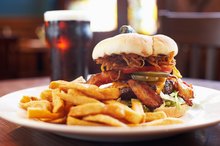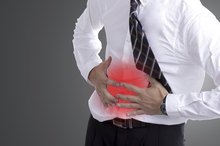Next to heartburn, the most common symptom of acid reflux disease -- also known as gastroesophageal reflux disease, or GERD -- is regurgitation, which some people call the “wet burps.” It's what happens when stomach contents travel from the abdomen and into the esophagus, throat and mouth. About 80 percent of patients with acid reflux disease experience regurgitation with varying degrees of severity, according to Dr. Peter J. Kahrilas in the January 2013 issue of "Gastroenterology and Hepatology. 1"
If you are experiencing serious medical symptoms, seek emergency treatment immediately.
Symptoms of Regurgitation
People who suffer from regurgitation may experience a sour, bitter or acidic taste in the mouth and an unpleasant sensation of fluid moving up and down in the chest area. Over time, hoarseness or a breathy voice can develop when the vocal cords respond to regurgitated acid with inflammation and ulcers called granulomas. Difficulty swallowing, frequent throat clearing and the sensation of drainage from the back of the nose, or postnasal drip, are also common complaints.
Underlying Causes of Reflux and Regurgitation
How to Get Rid of Acid Reflux Burps
Learn More
The difference between reflux and regurgitation is matter of degree, although the terms are often used interchangeably. Reflux is when stomach contents escape the upper abdomen into the esophagus, often causing burning symptoms in the center of the chest. Regurgitation occurs when the liquids travel up from the stomach all the way through the throat and into the mouth. Both are caused by the weakening or loosening of the ring of muscles that serves as an anti-reflux barrier. This ring is the lower esophageal sphincter, or LES, which normally closes tightly after food is swallowed, to seal the stomach off from the esophagus. When the LES is compromised and unable to form the tight seal needed to shut, stomach contents escape upward from the stomach.
- The difference between reflux and regurgitation is matter of degree, although the terms are often used interchangeably.
- Reflux is when stomach contents escape the upper abdomen into the esophagus, often causing burning symptoms in the center of the chest.
Gravity and Regurgitation
High impact exercises such as jogging or aerobics, and activities such as yoga that involve bending or doubling over can trigger episodes of regurgitation. For many people, symptoms are worse at night when lying in bed.
How to Minimize or Avoid Regurgitation
What Are Good Exercises To Do When You Have Acid Reflux?
Learn More
- Lose weight, if applicable. - Eat smaller meals. - Avoid eating for three hours before exercising or going to bed. - Elevate the head of your bed by 6 to 8 inches, and sleep on your left side. - Avoid foods that loosen or relax the LES, especially caffeinated beverages, chocolate, alcohol, mint, onion and garlic. - Avoid high impact activities such as jogging or aerobics. - Avoid exercises that require you to bend over, lie head-down on an incline or turn upside down. - Wear looser fitting clothes and avoid body-hugging garments that can put pressure on the LES.
-
- Lose weight, if applicable.
- Lose weight, if applicable.
-
- Avoid exercises that require you to bend over, lie head-down on an incline or turn upside down.
- Avoid exercises that require you to bend over, lie head-down on an incline or turn upside down.
- -
Medical Solutions
Although drugs called proton pump inhibitors, or PPIs, are usually the first line of defense against acid reflux and are highly effective, they are widely regarded as less successful for treating regurgitation. For severe cases, surgery may be an option. Nissen fundoplication is among the most commonly performed surgeries for reflux and regurgitation. Though there are many variations in how it's performed, it generally involves taking a part of the stomach and wrapping it securely around the lower end of the esophagus. Successful fundoplication strengthens the LES, restoring its function as the “one-way valve” to prevent acid reflux.
Medical advisor: Jonathan E. Aviv, M.D., FACS
- Although drugs called proton pump inhibitors, or PPIs, are usually the first line of defense against acid reflux and are highly effective, they are widely regarded as less successful for treating regurgitation.
Related Articles
References
- Gastroenterology and Hepatology: Regurgitation in Patients with Gastroesophageal Reflux Disease, January 2013; Peter Kahrilas, MD
- 100 Questions and Answers about Gastroesophageal Reflux Disease (GERD): David L. Burns, M.D., CNSP, and Neeral L. Shah, M.D.
- American Gastroenterological Association Treatment Guidelines: Gastroesophageal Reflux Disease (GERD); Peter J. Kahrilas, et al.
- Goyal & Shaker GI Motility Online: Laryngeal and pharyngeal complications of gastroesophageal reflux disease, Gregory N. Postma, M.D. and Stacey L. Halum, M.D., May 2006
- National Institute of Diabetes and Digestive and Kidney Diseases. Symptoms & causes of GER & GERD. November 2014.
- National Institute of Diabetes and Digestive and Kidney Diseases. Diagnosis of GER & GERD. November 2014.
- Harvard Women's Health Watch. 9 ways to relieve acid reflux without medication. Harvard Health Publishing. September 10, 2019.
- US Food and Drug Administration. Over-the-counter (OTC) heartburn treatment. March 3, 2018.
Writer Bio
Martin Booe writes about health, wellness and the blues. His byline has appeared in the Washington Post, the Los Angeles Times and Bon Appetit. He lives in Los Angeles.








